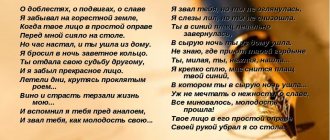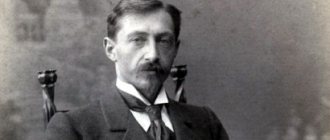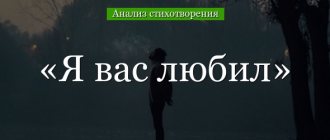Image of the Stranger
Blok's Stranger is a transformed image of the Beautiful Lady, which has acquired real features. An elegant woman, light and fragile, dressed in a dark veil. She stands out so much from the general picture of her environment, as if she had descended from a completely different reality, devoid of rudeness, vulgarity and constant drunkenness. She appears like a dream, shrouded in mystery and alluring beauty. “Bottomless blue eyes” are full of charm and mystery. The stranger is the “lifeline” of the lyrical hero, this is what he needs to get out of the bottomless abyss. In addition, this image helps to create the effect of two worlds and show the duality of the narrator’s consciousness. Despite the fact that thanks to the stranger he is momentarily distracted from the rough and difficult reality, the world around him does not disappear anywhere, although it temporarily fades into the background. This woman reflected all the poet’s romantic dreams and his faith in goodness. She is the embodiment of romance and purity, which purifies the poet, helping him ultimately give up drunkenness and make a choice in favor of life.
Analysis of the poem “Stranger” by Alexander Blok
At the beginning of the poem, Blok paints an ordinary picture that is stunning in its depth and realism. On the one hand, a sound background emerges before us: children’s crying, drunken shouts, women’s squeals, the creaking of rowlocks - all this gives rise to a pernicious spirit. On the other hand, a visual background also appears: dust, an advertising sign for a bakery, barriers - all this contributes to the description of the life of ordinary people who are burdened only with earthly concerns. The monotony of what is happening and its hopelessness is emphasized by the twice repeated verb: “a child’s cry is heard,” “a woman’s squeal is heard.” The image of the sun is lowered to a meaninglessly curved disk, which is only needed to correspond to the vulgarity and madness of what is happening.
The lyrical hero is immanently uninvolved and indifferent to everything, which indicates loneliness. The motif of detachment is aggravated in the fifth stanza, when the only friend who is similar in emotional and mental terms to the lyrical hero turns out to be only a reflection in a glass of wine. The image of wine is symbolic, emphasizing the motif of mystery.
The sixth stanza is imbued with antipathy and contempt of the lyrical hero for the world of ordinary people. The lackeys “stick out”, and the eyes of drunkards are compared to the eyes of rabbits, thereby emphasizing their animal nature. The Latin saying uttered by drunkards once again speaks of their insignificance, since such a sublime phrase is uttered by vulgar and complete people.
Composition
The composition is divided into two parts. This system allows you to better reveal the author’s main idea and depict the contrast of opposites. The first part (six quatrains) depicts the realities of the vulgar, low-lying world. The second (the next seven quatrains) tells us about the sublime world, the focus of Blok’s dreams, which seems so thin and unattainable, but at the same time, it is the only thing that helps the hero to save himself and not fall into the dull and dark abyss of the reality surrounding him. These two spaces are so incompatible, so parallel, that it seems that one of them is an illusion or hallucination. But in this contrast, the poet wanted to express his desire for pure and selfless love, which even the most immoral and vulgar reality cannot tarnish.
main idea
Even in the most callous, low and wretched world you can find beauty, you just have to believe in it. In such a fragile feminine nature, the hero saw an incredibly strong personality who, despite her mental torment, copes with her experiences on her own, without looking for “oblivion in wine.” This is what struck the lyrical hero to the core and made him think. Thanks to the stranger, the hero indulges in reflection about his own life, begins to analyze his behavior and admits his mistakes. As if having seen the light, he understands that every person may face difficult trials, but he must find the strength to cope with them. We must not give up, there is no point in inaction and drunkenness, everything depends only on ourselves. The beauty inspired the narrator so much that he became inspired and forgot about the surrounding vulgarity. This means that the soul needs to see and appreciate the beauty around itself - this is the main idea of “The Stranger”. You should not sag under the burden of problems, only then will a person be able to find harmony with himself, spiritual fulfillment, fortitude and cope with all the trials and sorrows that life has in store. And the beauty of the world around him will help him in this. It is she who needs to be let into the heart. Here Dostoevsky’s important thought continues to live: “Beauty will save the world.”
Images are symbols of stanza 3. Associations
Key words – images – symbols of stanza 2. Associations.
Images are symbols of stanza 1. Associations.
Hot air, restaurant, evening, pernicious spirit. Pictures of a “scary world”. Oxymoron – spring and pernicious. Blok’s setting is not just a restaurant, but a restaurant, as if all the dirt and vulgarity of the big city were concentrated in one place. Here we speak about the atmosphere of the city, about the scorching emptiness and hopelessness: “wild and deaf” - the city. The poet’s field of vision comes into view of the everyday life of city life, which makes his soul painful.
The absence of music meant for Blok a lack of life, deadness. The dissonance, which in many of Blok’s poems is at war with the music of life, is a reflection of the anti-musicality of the “terrible world.” Expanded metaphor:
it is not only about air, but about life, a wild and deaf crowd, about the human soul, deaf to beauty, truth, to life itself. For Blok's early lyrics it would have been absolutely impossible to combine evenings with restaurants; there it would have been an ugly confusion of lexical series. In “The Stranger,” this turned out to be possible, since life itself mixes the beautiful and the ugly.
Student answers: over the dust of the alley, over the boredom of country dachas, the pretzel of the bakery. The theme of gray everyday life continues, into which the “bakery pretzel is slightly golden” intrudes.
Student answer on color symbolism (slide 15) Gray and black colors are the personification of some kind of mental crisis, stagnation, routine, they instill feelings of hopelessness, death of the soul. The pretzel turns golden - perhaps some kind of gap in the distance, hope, the yellow color changes to golden. Although for Blok the color yellow represents tragedy.
Among the ditches, tried-and-tested wits, oarlocks creaking, a woman's squeal. Vulgar everyday life is depicted ironically. A barrier is a symbol of an obstacle. By blocking the way for people, he does not let them out of this vulgar circle of restaurant amusements. Repetitions convey the persistence of depressing monotony, the suffocating boredom of bourgeois existence.
In the paired lines of the third stanza, only two sounds are given in a strong position: a-ы, и-ы. In these same lines, multi-syllable words make reading difficult, and this well reflects the vulgar, painful situation that is described here. Alliteration in the description of a dirty street, a pile of rough consonant sounds.
The squeal was deeply consciously and painfully perceived by Blok as an anti-aesthetic sound - cutting, tearing the nerves, capable of killing the sensitive soul of an artist and a person.
Composition. How many parts can a poem be divided into? (20 slide)
2 parts. The first half of the poem paints a picture of smug and unbridled vulgarity; in the second part, a contrasting image of the Stranger appears.
The poem has two parts, and the main literary device is antithesis, opposition. In the first part there is the dirt and vulgarity of the surrounding world, and in the second there is a beautiful stranger; This composition allows us to convey Blok’s main idea: the image of a stranger transforms the poet, his poems and thoughts change.
Blok also explained where he saw the Stranger - it turns out, in Vrubel’s paintings: “Finally, what I (personally) call “The Stranger” appeared before me: a beautiful doll, a blue ghost, an earthly miracle... The Stranger is not at all just lady in a black dress with ostrich feathers on her hat. This is a devilish alloy from many worlds, mainly blue and purple. If I had Vrubel’s means, I would have created a Demon, but everyone does what is assigned to him...” [1]. For Blok, the blue color means starry, high, unattainable; purple - alarming.
Images are symbols of the second part of the poem.
: every evening (anaphora), sleep, girlish form, in a foggy window. The image of fog further enhances the mystery of the Stranger’s appearance. The vocabulary is sublime. The transition to another picture is in direct contrast to the surrounding vulgarity.
Here everything is fragile, based on mystery, the soul is freed from the vulgar pressure of everyday life, flies away to other worlds, revealing treasures unknown to the world in its depths. The important thing is that the human soul came into contact for a moment with the world of beauty. We feel the sublime poetic perception of the lyrical hero, the charm and beauty of the mysterious heroine. This is not a real Stranger, but only a vision of the poet, an image created by his imagination.
Let's compare the sound design of the second part with the first.
The appearance of the Stranger (Lady from Space) is accompanied by rustling sounds. Logically, this can be explained by the fact that she is either wearing black silk (“black silk is noisy”) or with a train, but it can be compared to the arrival of something mysterious, inexplicable.
Assonances on A create a feeling of airiness of the image: “And every evening, at the appointed hour...”; “The girl’s figure, captured by silks, // In the fog (A) m moves (A) about (A) the sea...” and further. Assonances on “U” add sophistication to the image of the Stranger: “And I blow (U)t ancient beliefs // Her elastic silks, // And a hat with mourning feathers, // And in the rings of a narrow hand.”
The vocabulary of the first stanza (“And every evening my only friend...”) is high, similar to the vocabulary of the second part of the poem. The vocabulary of the second stanza (“And next to the neighboring tables...”) is low (“lackeys”, “sticking out”, “drunkards”, “screaming”), gravitates towards the vocabulary of the first part. Thus, these two stanzas seem to hold together the parts of the poem, penetrating into the fabric of the lyrical narrative. The everyday vocabulary of the first part is replaced by spiritual lines that are striking in their musicality.
Opposite images.
“The hot air is wild and deaf” - “Breathing with spirits and mists”; “female squeal” - “girlish figure”; “meaningless... disk” of the moon - “sun”; “boredom of country dachas” - “enchanted distance”; “ditches” - “bends” of the soul; “meaningless... disk” - “true”.
Generalizations and additions from the teacher: The image of the Stranger is filled with poetic charm, fenced off from the dirt of reality by the sublime perception of the lyrical hero.
She sits by the window.
And they breathe ancient beliefs
Her elastic silks
And a hat with mourning feathers,
And in the rings there is a narrow hand.
The dirt of the surrounding vulgar environment does not touch her, it seems to float above her, separated by silent loneliness, with its “mourning feathers.” She is like a messenger of another world, alien to everyone and everything, like Poetry and Femininity embodied.
Images: bottomless blue eyes, an enchanted shore, and an enchanted distance.
These are real female eyes, full of mystery and charm, this is also a symbol of the eternal beauty of the world, spring and blooming, which still exists, despite the universal power of the stuffy city, exists even if only in a dream. The loneliness of the heroes sets them apart from the crowd, attracts them to each other: And chained by a strange closeness...
Behind this real or imaginary appearance, the lyrical hero sees “an enchanted shore and an enchanted distance.” The shore is Blok’s symbol, the meaning of which is new life, new discoveries, a new understanding of life and poetry. This association takes on the meaning of a real-life opportunity to sail to the other shore of life, to go into the “enchanted distance” from vulgarity, which a minute ago seemed invincible.
Silent secrets have been entrusted to me,
Someone's sun was handed to me...
The sun is a symbol of Femininity, a symbol of happiness and love.
Generalizations and additions of the teacher: The last stanza completes the revolution in the soul of the lyrical hero, is built on the understanding of the revolution that has taken place in the soul and the rethinking of the established, familiar, speaks of his chosenness, of the imperishability of the beautiful ideal:
There is a treasure in my soul,
And the key is entrusted only to me!
You're right, drunken monster!
I know: the truth is in the wine.
The discovery of poetry, initiation into the secrets of the charm of another world, albeit in the imagination, is established as truth. Thus, beauty, truth and poetry are linked in an inseparable unity.
Criticism: However, the poem “Stranger” attracted readers and interpreters
tors of Blok's lyrics both as a unique literary text and as a kind of
evidence of a unique spiritual experience. According to S. A. Vengerov, Blok
“managed to create a whole mystical-real poem, where
visionary with real life"3. V. M. Zhirmunsky saw in “The Stranger”
romantic “two worlds”, combining everyday life with mystical
such insights: “Now (that is, during the writing of “The Stranger.” - D.M.)
each poem by Blok develops in two different plans: first
the plan is everyday, real, “reality”, the second plan is super-real,
in which spiritual events take place, the only important and intimate ones for the poet.
interesting." Among the works specifically devoted to the analysis of this poem, stand out
The article by Z. G. Mints “On one way of forming new meanings of words in
work of art (ironic and poetic in Al. Blok’s poem
"Stranger" The article analyzes only the first four stanzas (before the words
“The senseless disc is bent”), depicting “a world without a poet and without a Stranger”5.
Observations by Z. G. Mints introduce new significant accents into the interpretation
“two worlds”, which everyone who wrote about the poem spoke about. Usually used
investigators paid attention to “vulgarity”, “ugliness”, “unaesthetic”
world of the first part of the poem, pointed to the prevailing in its description
nii material objectivity (restaurants, dust, dachas, bakery pretzel, slag-
baums, ditches, pots, glasses, tables, drunkards, etc.). It was also said that
that “the natural itself becomes “meaningless”, ugly distorted from
wedging into it, merging with it quite disgusting social principles”6.
Clarifying these observations, Z. G. Mints indicated that the first part of the poem
is formed not only by non-poetic vocabulary with sharply negative connotations -
tions, but also words and phrases that came from “Poems about Beauty”
Noah Dame": evenings in the world of the first volume of the "lyrical trilogy" are sacred
the time of the hero’s “meeting” with his mystical beloved, nature (lake, sky,
spirit, spring) is the sphere of Her presence. Dali (in the distance above the dust of the alley) - her
familiar space. But in combination with negative language, all these “signs”
Her presences are reduced, devalued and become the subject of hidden
or obvious ridicule (female squeal instead of Eternal Femininity): “Words and
phrases that characterized the “high world” of the Beautiful Lady rendered
are introduced, entering into new words and phrases, by characterizing the world “earthly”
"li" - anti-aesthetic, from the point of view of the aesthetics of the "first volume". Inspired by
structure of “Poems about a Beautiful Lady,” the usual use of words
is constantly destroyed, there arise - for the reader's expectation - permanent
surprises: “spirit” is interpreted as a synonym for the words “smell” and even “stench”, “zo-
it’s not the “domes” that are floating”, but the “pretzel of the bakery”, in the “sky” not “clear dawns” are visible. stuttering, vulgar, by analogy with the already existing tradition of “romantic
irony”, as well as with traditional techniques used within the data
of this text <...> can be perceived as creating the effect of irony”7.
According to the researcher, the second part of the poem “is built on
on a different (somewhat “reverse”) principle.” Now the quantitative predominance
give words that are especially significant for “Poems about a Beautiful Lady,” although they remain
combination of different types of elements. “Accordingly, although irony does not disappear,
the role of lyrical intonations increases. At the same time, however, the concept of “poetry”
tical” includes what, from the point of view of the aesthetics of the “first volume”, was only
“low”: this includes both completely earthly “perfume” and “a hat with mourning feathers”
yami”, and “elastic silks”. This turn to the artistic perception of the “earthly”
go" as "poetic" is, as is known, one of the main features
evolution of Blok the lyricist"8.
In the book of M. L. Gasparov “Meter and Meaning” the semantic ore-
ol iambic tetrameter with dactylic and masculine endings. Having traced
the formation of this size before “Stranger”, M. L. Gasparov indicated that “she
arose at the intersection of two motives: external passage and internal pro-
vision, external urban life and the internal feeling of eternal femininity
ness. The first of these motifs goes back to Bryusov, the second to Gippius <…>
The chamber etherealness of Gippius combined with the street eroticism of Bryusov, and
This is where the unique imagery of Blok’s poem came from.”9 In the works of P. P. Gromov, the poem is correlated with the plot of the same name.
lyrical drama, where the Stranger is a star that fell from the sky and turned
turning into a beautiful woman (in the poem this theme of “comet” is fully
completely lost). According to the researcher, the poem and the play have a common
theme - “the contradictions of modern consciousness and, accordingly, love
modern man"10.
These, in the most general terms, are the directions for studying “The Stranger.”
Subjects
Spiritualized people suffer more often. Their worldview is more complex than that of inveterate ordinary people with their everyday consciousness. They face not so much external as internal obstacles: they live more in thought than in body. Therefore, the main theme in the poem “Stranger” is the collision of reality and dreams. Blok also experienced this conflict and could not ignore it in his work. On the contrary, he sought to pour out his feeling on paper and heal.
To embody the drama of the internal struggle, the author uses the techniques of opposition or antithesis. The bright romantic ideal is contrasted with harsh reality. This conflict is typical of the romantic movement, to the channel of which, as to its origins, the symbolist poet returned.
"Stranger" by Blok. Analysis according to plan
At school we are taught to analyze poems according to a scheme, analyzing three important components: historical and biographical, literary (composition, theme, images, style) and artistic (means of expression, rhyme, sound writing). They can be swapped depending on the tasks at hand. Let us analyze the poem “Stranger” by Blok according to the plan indicated below:
- History of creation.
- Composition.
- Artistic media.
- "I" of the lyrical hero
- Main thought.
- Reviews from critics.
The world in Blok's "Stranger"
The main character is filled with complete disgust for everything that happens around him. He tries to drown out the hardships, experiences and torment of a lonely existence with wine. The narrator seems to be in a labyrinth of drunkenness, hopelessness and meaningless existence, from which there is no way out.
Everything here is devoid of beauty and harmony. And suddenly, among this thundering abyss, the Stranger appears, shrouded in a mysterious haze and the aroma of perfume. She will become the embodiment of the beautiful and feminine, the personification of everything that the world is so lacking - love, harmony and sublimity.
A stranger is a dream. She colored the stench of everyday life with the smell of exotic flowers and unknown countries. Her arrival awakens the author’s imagination and muse, forcing him to rise above the vanity and hustle and bustle, to indulge in love, albeit invented, mysterious, ephemeral, but still enchanting and exciting his feelings offended by reality.
For the Russian poet, the tavern traditionally serves as a symbol of unnatural and cruel reality. Just remember Yesenin, who did not devote half of his lyrics to drunkenness. No, the point is in the perception of this place: a dirty, fetid and vicious world of people who intoxicate and poison themselves, just not to see everyday squalor - this is what the poets mean by this image. Each of us lives in oblivion, otherwise it is simply impossible to get used to the thought of the futility and sinful essence of existence.
Literature lesson on the poem “Stranger”: a real woman or A. Blok’s dream?
Literature lesson on the poem “Stranger”: a real woman or A. Blok’s dream?
Target:
- Show how the mood and tonality of Blok’s lyrics changes in Book II of poems using the example of the poem “Stranger.”
- Develop skills in analyzing a lyric work.
- Instill a love for Russian poetry, develop aesthetic taste.
Lesson equipment:
- portrait of A. Blok, reproduction of Vrubel’s painting “Demon”;
- reproduction of I. Glazunov’s painting “Stranger”.
During the classes
I. Organizational moment.
II. Frontal survey on homework:
1. What facts of personal biography were reflected in the poetry of the early A. Blok?
( Student answer.
At the beginning of 1900, two significant events happened that influenced the personal life and literary fate of A. Blok - love for L. D. Mendeleeva and marriage to her in 1903, passion for the philosophical works of V. S. Solovyov. Blok’s first book of poetry appears - “Poems about a Beautiful Lady” (1904-1905), which placed its author in the circle of prominent Russian poets. Blok’s name is becoming famous; he communicates with symbolists of the older and younger generations.)
2. What are the features of the poetics of the first volume of “Poems about a Beautiful Lady”?
(Student answer.
Solovyov’s idea of the World Soul, or Eternal Femininity, had a particularly great influence on Blok. Blok most accepted the thesis that “in individual love, world love is manifested, and love for the world itself is revealed through love for a woman.” The symbol becomes a “sign of another world.” The world and everything in the world is seen as a symbol of the infinite, heightened perception caught the imprints of a different reality.
“Poems about a Beautiful Lady” is a kind of lyrical diary of intimate love experiences. Love is depicted as a rite of service to something higher. Vague forebodings, anxious expectations, mystical insights and omens fill the poems. The ideal world is contrasted with the events of real reality, which the poet recreates in abstract or extremely generalized symbolist images. For example:
...Here, below, in the dust, humiliation, Seeing for a moment the immortal features, The unknown slave, filled with inspiration, sings to you. You don't know him. (“Transparent, unknown shadows...”)
3. What three looks and three plans of the lyrical heroine can be identified in the early lyrics of A. Blok?
(Student answer.
In cosmic terms – the Soul of the world; in religious terms - the Queen of Heaven; in everyday terms - a beloved, in whom the features of L. D. Mendeleeva can be discerned
III. New material:
Teacher.
Look at the topic of the lesson and say:
- What are we going to talk about today?
- What should we find out?
(Sample student answers.
We will talk about the mood and tonality of Blok’s lyrics in the second book of poems using the example of the poem “Stranger”; analyze it (the poem) and find out: “Stranger” is a real woman or the poet’s dream.
Write down the date and topic of the lesson.
Teacher's word.
Today we will turn to the second collection of poems by A. Blok, “The Incarnation Trilogy,” and talk about his poem “The Stranger.”
A. Blok’s poetic debut occurred during the years of the first Russian revolution (1905 – 1907). She came - the revolution - one of the incarnations of the Beautiful Lady, replacing the usual features, and “disturbing the calmness of the poet”, who entered his world - street noise. In just a few months, he changed so much that his close friends stopped recognizing him. Vladimir Solovyov, to whom A. Blok wrote about his “Vrubel” hobbies, spoke about the poet’s “treason,” calling him a liar and a slanderer. The sublime mystery of the Beautiful Lady is supplanted by the mystery of the vicious city. New poetic dissonances are ripening in the poetic soul, which is shocked by the horror of life, loneliness, but not the same - in anticipation of mystical means, but a painful detachment from reality. A. Blok’s recent friends had a long time to catch up with him, who suddenly became wise.
At the beginning of 1906, A. Blok wrote “The Stranger.” What impressed A. Blok so much that the poet picked up a pen? Let's listen. (A student prepared in advance talks about the history of the creation of the poem “Stranger”).
Student.
The poem was born from wanderings around the St. Petersburg suburbs. On May 9, 1906, the young writer Yevgeny Ivanov wrote in his diary a story about a trip with Blok out of town. Blok took him to Ozerki, a holiday village near the Finnish Railway station. Blok led him to the lake, where “the rowlocks creaked” and “a woman’s squeal,” where everything was squalor, boredom and vulgarity. And it was then that the need for something else to happen in the world besides this “dacha life” became quite obvious.
“Then Sasha, with some tenderness towards me, pointed to the gilded pretzel of the bakery, to the signs. He showed all this with great love, as if wanting to introduce me to the path that he was following then, that evening when “The Stranger” appeared. Finally I was brought to the station by Ozerkovsky. From a small Venetian window one can see the “barriers”, he pointed out all this in verse. The railway is visible through the window. Trains often rush past... A piece of the sky, green at dawn, then closes and then opens. The appearance of “Strangers” in the window is connected with these passing cars.
By undertaking to be a guide on this literary walk through the dusty streets of this dacha village, Blok proved to both his friend and himself the reality of his own fictions. Of course, special, purely spiritual - but still the undoubted authenticity of the fantastic event he described.
Reading and dramatization of a poem by students accompanied by musical accompaniment.
(In the center of the class there is a small table on which there is a wine glass with a candle. The student sits on a chair. He begins reading the poem “Stranger” accompanied by music. At this moment, a student slowly and mysteriously emerges from the “depths” of the class in the image of the Stranger (dark dress, hat with wide brims and feathers, a black veil on her face) and sits down next to the reader (A. Blok). At the end of the poem, the Stranger also mysteriously gets up and leaves.)
(This action takes place with the aim of creating that fabulously mysterious atmosphere that A. Blok spoke about.)
Teacher.
And now we will try to understand A. Blok’s worldview and analyze his poem “Stranger”.
IV. Analysis of the poem.
— How is the poem constructed, what is its composition?
(Student.
The poem is built on the contrast of paintings and images, contrasted and reflected in each other. The first part paints a picture of smug, unbridled vulgarity. The beginning conveys the general atmosphere and its perception by the lyrical hero.
In the evenings above the restaurants the hot air is wild and deaf, and the spring and pernicious spirit rules over the drunken cries.)
— Do you think the poem is only about the restaurant?
(Student
. This is probably not just a restaurant, but restaurants. Here you can see a subtle hint of the atmosphere of the entire city, of the scorching emptiness and hopelessness of life, of the deaf, wild crowd and human callousness.
— What are the features of the images?
(Student.
The images are oxymorons: epithets with opposite meanings are combined - “spring” and “pernicious”. Vulgar everyday life is depicted ironically.
And every evening, behind the barriers, wringing their bowlers, proven wits walk among the ditches with the ladies. Rowlocks creak over the lake, And a woman’s squeal is heard...
— Which vocabulary is more in the first part of the verse, “high” or “low”? Give examples.
(Student.
The vocabulary of the first stanza “And every evening the only friend...” is high, similar to the vocabulary of the second part of the poem. The vocabulary of the second stanza “And next to the neighboring tables” is “lackeys”, “sticking out”, “drunkards”, “screaming”. These two stanzas connect the parts of the poem, penetrating the fabric of the lyrical narrative.
—What mood permeates the second part of the poem? Prove it with examples?
(Student.
The second part of the poem is a transition to another picture, contrasted with the vulgarity of the first. The first two stanzas express the humble despair and loneliness of the lyrical hero.
And every evening my only friend is reflected in my glass And with tart and mysterious moisture, Like me, humble and stunned.
— Why do you think Blok turns to the image of evening time? “And every evening my only friend...”
(Student
. In classical poetry, evening is the most poetic time of day, a time of peace, harmony and quiet sadness, the month is one of the most poetic images. In Blok, he takes part in a meaningless human round dance, and this is no longer a month, not the moon - an ordinary disk. This is how the picture of a meaningless existence, devoid of beauty and harmony, gradually unfolds.
Teacher.
But, despite all the vulgarity and ordinariness of the world around us, there is a place for miracles in human life.
-Who is the miracle in Blok’s poem? Why?
(Student.
A miracle, or rather a monster, of this world, a beautiful Stranger appeared. Her very vision appears as if from the evening twilight, from the vulgar scream of drunkards, the creaking of rowlocks, the squealing of women, and appears as a denial of a disharmonious world. The Stranger is an image of another world, mysterious and incomprehensible, strangely disturbing the soul.
— How is the title character of the poem portrayed, are the author given specific features to her? Prove with examples from the text.
(Student.
The Mysterious Stranger is the title image, which appears only in the second part of the poem. But apart from the title of the poem, it is not directly indicated anywhere. At first glance, the heroine is devoid of realistic features; she is completely shrouded in silks, perfumes, mists, and mystery. The stranger is full of poetic charm, fenced off from the dirt of reality by the sublime perception of the lyrical hero:
And her elastic silks waft with ancient beliefs, And her hat with mourning feathers, And her narrow hand in rings.
— How is the lyrical hero close to the mysterious stranger, being “among the drunks”?
(Student.
The Mysterious Stranger is alien to the surrounding reality; she is Poetry and Femininity embodied. And she, too, is “always without companions, alone.” The loneliness of the heroes sets them apart from the crowd and attracts them to each other.
And chained by a strange intimacy I look at the dark veil, And I see the enchanted shore And the enchanted distance.
— What, in your opinion, is an “enchanted distance” for a lyrical hero?
(Student
. Probably, the “enchanted distance” is a wonderful future, without the vulgarity and dirt of the surrounding world, but for now this “distance” is inaccessible to the lyrical hero. The fairy fog will clear, and everything beautiful will float away.
— What changes after the appearance of the Stranger: the world around us or the consciousness of the hero?
(Student.
The hero’s consciousness will change, as he is proud of his dedication to other people’s secrets, perceiving them as “someone’s sun,” as a gift that needs to be carefully preserved.
Silent secrets have been entrusted to me. Someone's sun has been entrusted to me.
There is a treasure in my soul, And the key is entrusted only to me.
(Student.
In the hero’s mind, the guessed secret, which opens up the possibility of another, beautiful life, far from the vulgarity of reality, is accepted as a found “treasure”.)
— Why at the end of the poem does the lyrical hero exclaim: “I know: the truth is in wine”? What does he mean?
(Student.
This phrase appears twice in the poem. The first time it sounds from the lips of drunkards is like the slogan of a disharmonious world. The second time it sounds during the awakening of the lyrical hero from his dreams. This awakening is tragic. The image of the stuffy world rises again, rises at the very moment when happiness seemed to be found.
Teacher's explanation.
Besides, guys, wine is also a symbol of revelation, the key to the secrets of beauty. Beauty, truth and poetry find themselves in an inseparable unity.
— Let us pay attention to the expressive instrumentation of Blok’s verse. Find examples of sound recording.
(Student.
The appearance of the heroine is accompanied by a sound recording of rare beauty (assonance and alliteration), creating a feeling of airiness of the image: “And every evening, at the appointed hour...”; “The girl’s figure, captured by silks, / In the fog (A) moves (A) about (A) the knA...”. Assonances on “u” add sophistication to the image of the Stranger: “And I breathe ancient beliefs / Her elastic silks, / And a hat with mourning feathers, / and a narrow hand in rings.”
- Stranger - who is she? A real woman or a poet's dream?
(On the one hand, there is reality. An unfamiliar girl may appear among restaurant tables, among drunks; and these are real female eyes, full of mystery and charm, a description of a slender figure. But on the other hand, it is a dream, a dream: “breathing spirits and mists,” this a symbol of the eternal beauty of the world, spring and blooming, which still exists, despite the universal power of the stuffy city. The Beautiful Stranger - whether it is reality or a vision coming from other worlds - no longer has much meaning. What is important is that the human soul came into contact with the world for a moment beautiful.
Figure No. 1. Illustration for A. Blok’s poem “Stranger” by I. Glazunov.
Figure No. 2. Reproduction of Vrubel’s painting “Demon”
— Guys, look at the reproduction of Vrubel’s painting “The Seated Demon” and I. Glazunov’s illustration “Stranger”, tell me, what do you think they can have in common?
(Student.
The tone of the paintings is the same: blue-lilac, the mood of the characters: sadness, boredom, faith in something beautiful, external beauty.)
V. Lesson summary.
- What did we talk about?
(Student.
We analyzed A. Blok’s poem “Stranger”...)
- What did you find out?
(Student.
They found out that the Stranger is both the reality of his (Blok’s) worldview and the poet’s dream of a wonderful future.
Teacher.
Guys, let's listen to the poem again to enjoy its sound and depth of meaning in a new way.
VI. Student assessment.
VII. Homework.
Learn the poem “Stranger” by heart.
History of creation
The poem was written during an extremely difficult period for the poet. His wife cheated on him with his friend, Andrei Bely; in addition, in the same year, Alexander made a break with the symbolist poets. Of course, such shocks could not but affect his work. All these wanderings, emotional experiences and impressions are reflected in “The Stranger”. Apparently, the author decided to create an illusory reality for himself as a refuge from earthly suffering. The dream of an ideal, embodied in the poem, gave him the incentive to live and create. After all, if there is beauty, clothed in rhyme, then there is also the purpose of the creator, given to Blok from above.
Epithets of the Stranger
Epithets are definitions attached to words that improve their expressiveness and add beauty to pronunciation. In Stranger, Alexander Blok used several epithets, here is the full list:
- Child's cry.
- Hot air.
- Tested wits.
- Drunken shouts.
- Noxious spirit.
- The Enchanted Coast.
Using the last epithet as an example, we see that the coast takes on charming features and becomes beautiful even without a detailed description. Drunken shouts - and we can immediately hear them - are shouts in slurred language, in which the boundaries of decency have been frayed.
In a similar way, you will reveal other epithets of this poem.
The image of a lyrical hero
The main character is a lonely wanderer. A person who rejects the reality around him. He is dissatisfied with his own life, he has simply lost interest in it and has lost any incentive to exist, he is weak and does not see the point in resisting the blows of fate, letting himself drift with the flow of “alcoholic” rivers. The entire reality surrounding him resembles a noisy booth, where there is nothing sacred, spiritual or beautiful. The world is killing him, squeezing him in its suffocating embrace of drunken stupor. He has no friends who could support him and guide him in the right direction. Everyone around him is a lover of swearing and cheap booze.
The stranger appears unexpectedly, filling the hidden corners of the hero’s inner world with light. She becomes the only outlet, helping him forget about the reality that poisons him and find true ideals to strive for.
The hero realizes that not everything is lost in his life, there is still something that can excite his stony heart. But only he himself can help himself rise from the bottom, only he is entrusted with the key to the treasure of his own soul.
LiveInternetLiveInternet
Alexander Alexandrovich Blok
In the evenings above the restaurants the hot air is wild and deaf, and the spring and pernicious spirit rules over the drunken cries.
In the distance, above the dust of the alley, Above the boredom of country dachas, The pretzel of the bakery is slightly golden, And a child’s cry is heard.
And every evening, behind the barriers, wringing their bowlers, proven wits walk among the ditches with the ladies.
Over the lake, rowlocks creak and a woman’s squeal is heard, And in the sky, accustomed to everything, the disk is meaninglessly bent.
And every evening my only friend is reflected in my glass And with tart and mysterious moisture Like me, humble and stunned.
And next to the neighboring tables Sleepy footmen hang around, And drunkards with the eyes of rabbits “In vino veritas!” they scream.
And every evening, at the appointed hour (Or am I just dreaming?), the girl’s figure, captured in silks, moves through the foggy window.
And slowly, walking among the drunken, Always without companions, alone, Breathing in spirits and mists, She sits down by the window.
And her elastic silks waft with ancient beliefs, And her hat with mourning feathers, And her narrow hand in rings.
And shackled by a strange intimacy, I look behind the dark veil, And I see the enchanted shore And the enchanted distance.
Deep secrets have been entrusted to me, Someone's sun has been handed to me, And all the souls of my bend have been pierced by tart wine.
And bowed ostrich feathers sway in my brain, And bottomless blue eyes bloom on the far shore.
There is a treasure in my soul, And the key is entrusted only to me! You're right, drunken monster! I know: the truth is in the wine.
Ilya Glazunov “Stranger”
When it comes to the creative heritage of the Russian poet Alexander Blok, many often recall the textbook poem “The Stranger,” written in 1906 and which became one of the best romantic works of this author.
"The Stranger" has a rather sad and dramatic backstory. During the period of writing the poem, Alexander Blok was experiencing a deep spiritual drama caused by the betrayal of his wife , who left for the poet Andrei Bely. According to the recollections of the poet’s relatives, he uncontrollably drowned his sorrows in wine, and sat for days on end in cheap drinking establishments filled with dubious personalities. It is likely that in one of these restaurants Alexander Blok met a mysterious stranger - an elegant lady in a hat with a mourning veil, who every evening at the same time occupied a table near the window, indulging in her sad thoughts.
In this establishment she clearly looked like a foreign creature, belonging to a completely different world, where there was no place for dirt and street language, prostitutes, gigolos and lovers of cheap booze. And, quite likely, it was the image of the mysterious woman, so out of place in the interior of a cheap tavern, that awakened in the poet the desire not only to delve into her secret, but also to analyze his own life, realizing that he was wasting it.
Describing the situation around him, Alexander Blok deliberately contrasts dirt and drunken stupor with the divine image of an unknown woman , who, apparently, is experiencing an equally deep spiritual drama, but does not stoop to drowning her grief in alcohol. The realization that the fragile stranger turns out to be much stronger and more courageous than all those men who surround her gives rise to a certain semblance of admiration in the poet’s soul. This is the first bright moment in his life in many months, which he is trying to grab onto as if it were a life preserver in order to emerge from the abyss of unremitting drunkenness. The fact that he succeeded brilliantly is confirmed by the very fact of the existence of the poem “The Stranger,” which, as it later turned out, became a turning point not only in the life, but also in the work of Alexander Blok.
And it is precisely the contrast between the dark and light sides of life , which is very clearly visible in this lyrical and very exciting work, that indicates that the poet very clearly understands that his life is going downhill at an inexorable speed. Such an antithesis sets the rhythm for the entire work, as if emphasizing that there is another reality in which, even with a broken heart, you can rejoice and be surprised at simple things that evoke the brightest and most exciting feelings. The image of a stranger identifies a slightly open door to another reality, and all that remains is to take a couple of unsteady steps to find yourself where there is no place for the gloomy reality with its vulgarity, betrayal, cruelty and dirt.
Should I stay in the arms of Bacchus or try to get into the mysterious world of a stranger , filled with light and purity? Alexander Blok chooses the third path, arguing that there is truth in wine too, but at the same time, deciding not to stoop to the level of those who drink not in order to comprehend it, but in order to forget. This is confirmed by one of the last stanzas, in which the poet admits: “There is a treasure in my soul, and the key is entrusted only to me!” These words can be interpreted in different ways, but their most likely meaning is that only spiritual purity, the ability to love and forgive, give a person the strength to live on. But in order to realize this, you must first sink to the very bottom, and then meet a mysterious stranger who will make you believe in your own strength with just her presence, even if her image is a figment of the imagination, poisoned by alcohol.
Text: pishi-stihi.ru
Means of artistic expression
In this work, Alexander Blok was able to paint for us a picture full of visible images, sonority and even tangibility. He was helped by a large number of figurative means, such as: epithets (“sleepy lackeys”, “bottomless eyes”, “hot air”, “mourning feathers”), metaphors (“the only friend reflected in a glass”, “seized in silks”), comparisons (the eyes of drunkards with the “eyes of rabbits”), personifications (“the disk is crooked”).
In addition to bright visual paintings, the poem also contains remarkable sound motifs. For example, the sound -r- gives a feeling of anxiety, trembling, screaming, fear (“call”, “pernicious”, “right”, “restaurant”, “entrusted” and so on). Next we notice an abundance of sounds -a-, -o-, giving the impression of a slow, measured narrative. To convey sharp sounds, the author uses the sound -i-, and to create a feeling of smoothness and mystery - the sounds -l, -m, -n.
Author: Maria Nechaeva
Interesting? Save it on your wall!
Means of expression
As always, the poet uses bright expressive means in the poem, there are many of them and they all work on the artistic idea. The main ones are:
- Epithets - “hot air”, “drunken shouts”, “spring and pernicious spirit”, “children’s crying”, tried-and-true wits”, “enchanted shore”.
- Metaphors - “the spirit rules the shouts”, “the disc curves senselessly”, “the body captured by silks”, “breathing spirits and mists”.
- Comparison – “like me, humble and stunned.”
Epithets work especially clearly in this work: deliberately rude and ugly comparisons are used in the first part, which describes reality, and poetic and romantic ones - in the second.







